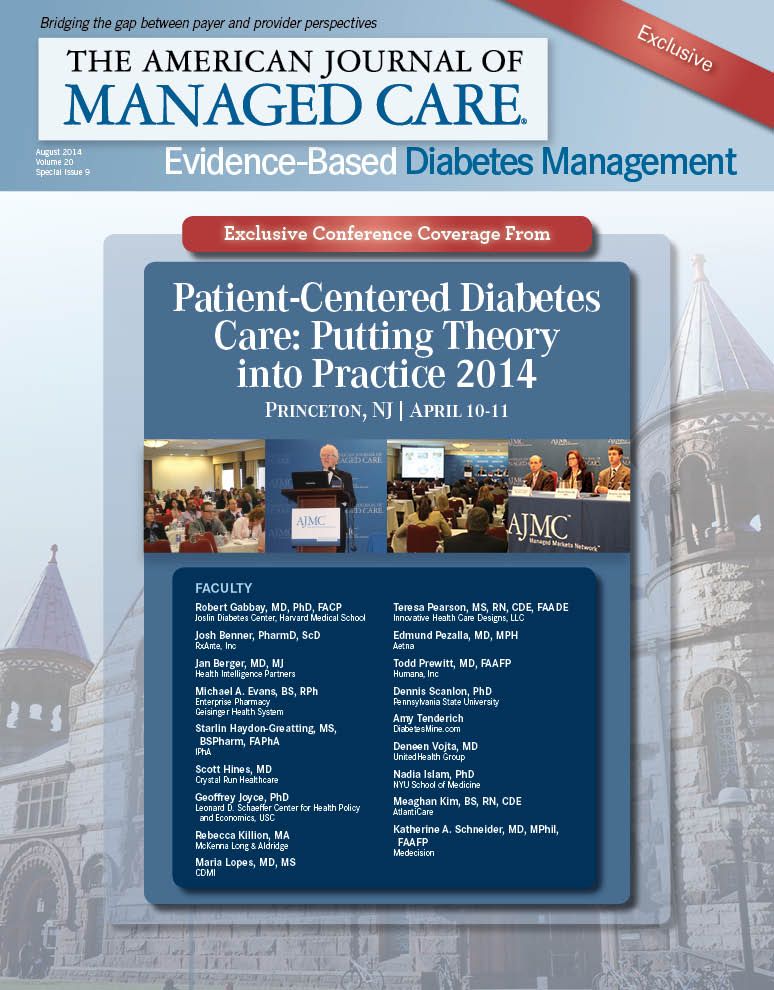Publication
Article
Evidence-Based Diabetes Management
Minnesota Model Highlights Power of Collaboration, Coordination
Pearson emphasized a coordination of care, between the primary care provider, the pharmacist, and payers, to improve patient care.
For all the talk about the need to coordinate healthcare, few examples make the case better than the story of Bill.
Teresa Pearson, MS, RN, CDE, told the story of this 55-year-old diabetic, who also has chronic obstructive pulmonary disorder (COPD) and needs dialysis. Bill has been hospitalized frequently and needs both physical and occupational therapy, and a diagram of his healthcare plan looks like a bicycle wheel, with the patient in the middle and more than a dozen spokes flowing from the center.
As Pearson noted in her talk, “Building an Effective and High-Quality Practice Model,” that doesn’t have to be a bad thing, if that care is coordinated by the right entity. Pearson is working with 12 counties in Minnesota to implement such a model, called Southern Prairie Community Care. It began with the realization that county governments were footing the bill for healthcare costs when, for instance, a patient with hypoglycemia wrecked a car, or when a person on anti-psychotic medication failed to stay adherent and ended up in jail.
What started as a shared savings model has evolved, Pearson said, as providers of healthcare have realized that true integration means incorporating issues related to prevention, mental health, housing, and livable wages.
In Minnesota, collaboration on measures of quality long predate accountable care organizations (ACOs) or even the Southern Prairie project. Efforts to coordinate on care guidelines in diabetes go back as far as 1993, Pearson said. When the most recent healthcare reform wave reached Minnesota, the great concern was losing safety-net providers in mergers, as smaller groups were acquired by larger ones, Pearson said.
Southern Prairie is neither a provider nor a health plan, she explained. Rather, it is focused on purchasing healthcare efficiently, through providers that are already in the community. Providers may work with a variety of payers and may provide some administrative services, but Southern Prairie focuses on the coordination and sets standards on early intervention and prevention, “to move the cost dial backwards,” Pearson said.
Pharmacists are heavily involved. Southern Prairie also seeks solutions to the fact that 11 of the 12 counties involved are “food deserts,” and nutrition has been identified as a health issue. The staff at Southern Prairie realize the need to work ever more diligently to incorporate the particular concerns of the enrolled Medicaid population. And they must deal more effectively with residents like Bill.
“Just about every provider is going to prescribe him a medication,” Pearson said. “So, the pharmacist may be the one who has the most global picture of what’s going on with Bill—unless he’s going to multiple pharmacies, and we know that happens as well.”
Taking care of this complicated patient means building stronger connections between providers, through a central point. Southern Prairie tries to be that central point, to avoid multiple points of contact for a patient. Pearson has seen as many as 19 in a single case. Community contacts may need to be included, too, such as those representing social services.
“At the center is the patient and the family with a quarterback, or what we call a quarterback,” Pearson said. “That may or may not be the care coordinator in the primary care [provider’s] office.” That’s because patients may see their PCP only 3 to 4 times year, while they see other community providers, such as a social worker, up to 3 to 4 times a week.
“The idea of selecting that quarterback…part of [our role] is helping the patient decide who that person should be. Who do they have the best rapport with? Who’s the person they feel most comfortable with?” she asked. Often, “a patient is not willing to share everything about what’s going on with their life with every person on the care team.”
This approach redefines what “treating to target” means. “It’s not just about medical and clinical issues,” Pearson stressed. “It’s also about making sure that they have affordable housing, and they have a [living] wage, they can get healthy food to eat, and that sort of thing. For some of these folks, their needs are so very basic.”
Dental care can be a major issue, Pearson said, as it can account for a large share of visits to the emergency department.
Once a plan is in place and a coordinator selected, care measures are important. In Minnesota, the optimal measures in Pearson’s program are glycated hemoglobin (A1C) of less than 8, blood pressure of less than 140/80 mm Hg, low-density lipoprotein (LDL) of less than 100, taking aspirin, and not smoking. Quite often, these measures are affected by events like a patient living in transitional housing. Providers are not happy when that happens, but they know the measures aren’t going away,
EBDM
Pearson said. “That’s why it’s so important to include the entire community in this.”







